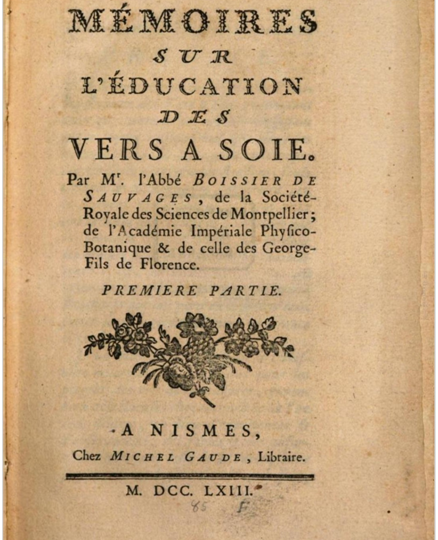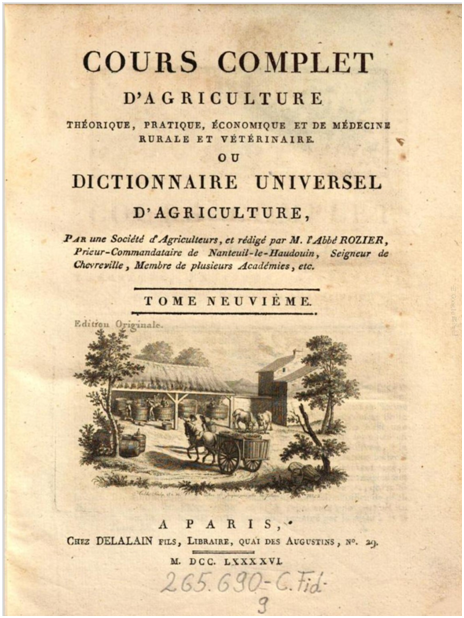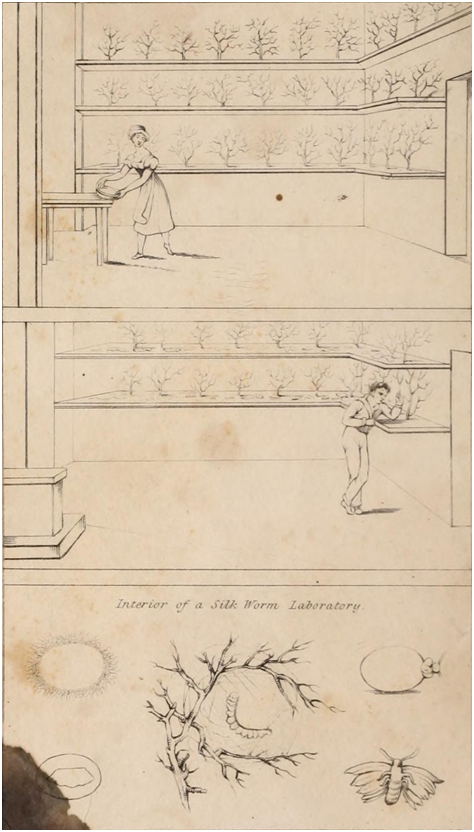
The welfare of silkworms raised for silk production, or sericulture, is the primary concern of silk growers. Before the introduction of scientific research, silk growers developed beliefs based on their limited sericulture experience and were often obsessed with what we now may dismiss as superstitions. For example, there used to be a widespread theory that silkworms could spawn spontaneously from rotten animal flesh.[1] According to Eastern Orthodox prayer books derived from a post-Byzantine tradition, some Greek silk growers believed that magic spells and malevolent glares would harm their silkworms like poisons.[2] Similarly, a more universal and enduring belief involves thunder and its impact upon silkworms in the “fifth age,” when they become noticeably transparent, stop eating, and start spinning. Silk growers usually provide small branches for these silkworms to climb so that they can attach themselves to the branches and form cocoons. This belief, which I refer to as the myth of thunder, maintains that the sound of thunder is disastrous to silkworms at this stage, causing them to drop from the branches and abort the cocooning process.
John Apokaukos, the Byzantine metropolitan of Naupaktos (central Greece) ca. 1200–1232, provided one of the earliest records of this belief in Europe. In his letter sent together with silk textiles to a friend, Apokaukos gives the following account of sericulture in his diocese: “(The silkworms) began to climb on the branches and compose the yarn in a cyclical manner… a sound of violent thunder dashed against (the silkworms) and threw those thunderstruck off the branches; (the thunderstruck worms) after spinning small amount of yarn… died in abortive cocoons. In this way… the crop from them was miscarried.”[3]
Louis of Granada (1504–88) testified to the same belief in his time, presumably in Spain or Portugal: “The Bombyxes, worms that spin the silk threads, are so troubled by the sound of thunder that sometimes they die. For this reason, their keepers often beat drums so that, being used to the softer noise, they may not be hurt by the heavier sound of thunder.”[4]
About a century later, Edward Digges, the British colonial governor of Virginia between 1655 and 1656 who tried to revive the intermittent silk production there, sent a letter to his cousin Dudley Palmer, a fellow of the Royal Society of London. In the letter, Digges reported that “Our country of Virginia is very much subject to thunders: and it hath thundered exceedingly when I have had worms of all sorts, some newly hatched; some halfway in their feeding; others spinning their silk; yet I found none of them concerned in the thunder, but kept to their business, as if there had been no such thing.”[5] In 1663, Abraham Hill reported to the Society that silkworms in Virginia, including those transported there from Europe, were not subject to any hurt from thunder,[6] a claim presumably based on Digges’ observations. That both Digges and Hill found the phenomenon worth reporting indicates that thunder was often considered detrimental to silkworms both in England and colonial America.
Rafael Bluteau (1638–1734), who was born of French parents in London but spent most of his life in Portugal, published a manual on mulberry and silkworm cultivation in 1679 to promote silk production in Portugal. In the manual, he suggested that loud noises, including those produced by bells, farriers, blacksmiths, and thunder, would harm silkworms unless they had become used to them. He advised that silk growers could invite people to the cocooneries and make noises during thunderstorms so that silkworms would adapt to such clamors and become better prepared for the sound of thunder.[7] The French writer Joseph Du Fresne de Francheville (1704–81) described in his poem on silkworms published in 1754 that unexpected piercing sounds like those created by cannons, bugles, and, in particular, thunder could knockdown and kill silkworms.[8] In the sericulture instructions accompanying his poem, the above viewpoint is made more explicit: “they (the silkworms) must be kept away from the noise of locksmiths, coppersmiths, and farriers; they are also afraid of bells, drums, gunshots, and thunder.” He also mentioned that it was common to put a key or a piece of wrought iron on the shelves of silkworms when it thundered to mitigate the sound’s impact.[9]
Du Fresne’s contemporary, French naturalist Pierre Augustin Boissier de Sauvages (1710–95), provided a more detailed description in this regard. In his 1763 sericulture manual he records that the silk growers in southeast France dreaded thunder because when it growled, the silkworms became too sluggish to climb the branches. Those already on the branches were knocked down to the ground, losing their strength to climb up again. If the thunderstruck silkworms did spin, they produced only defective cocoons. Following the same belief, loud noises, including drumbeats and cannon fire, were reduced or avoided in towns during the corresponding sericulture stage. To mitigate the alleged detrimental effect of thunder, silk growers resorted to remedies similar to those referred to by Louis of Granada and Rafael Bluteau: they introduced noises, for example, beating shovels and pans, scraping violins, or simply people talking, to prepare the silkworms in case they were caught off guard by the sound of thunder.[10]
Two years later, the French naturalist Matthieu Thomé submitted his treatise on mulberry and silkworm cultivation to Lyon’s Royal Society of Agriculture, in which he also suggested that the idea that loud noises would interrupt the cocooning silkworms was an ingrained belief.[11] By the end of the century, that the noise produced by thunder would cause silkworms to fall from the branches was still described as the most common opinion by the French agronomist François Rozier (1734–93) in his treatise on silkworms, published after his death as a part of his Cours complet d’agriculture.[12] In nineteenth-century Calabria (southern Italy), the same belief seemed to have been widespread, as demonstrated by a proverb in Greek dialect that goes as follows: “When I had put my silkworm on the branch, it thundered.” The proverb means that when I was about to reap the fruit of my labors, something happened that ruined all the efforts.[13]

Fig. 2. The title page of François Rozier’s Cours complet d’agriculture, vol. 9.
Though attested in various sericulture practices in the West for over six centuries, the myth of thunder was not perpetuated without challenge. While Du Fresne reiterated the myth in his works, he also expressed skepticism. He proposed that the sound of thunder perhaps did silkworms less harm than the preventive measures silk growers commonly took against the thunderstorm, that is, to close doors and windows, which blocks outside air from reaching the silkworms and thus suffocates them.[14]
The most comprehensive and far-reaching investigation of this myth came from Boissier, who designed a pioneering controlled experiment to test it. He applied drumbeats and pistol fires from different distances to mature silkworms ready to climb up on the branches and spin. It turned out that sound did not affect these silkworms at all. Thus, Boissier concluded that thunder affected silkworms not through its sound. Instead, he believed that it was thunderstorm’s effects upon the air that should be blamed: the weather charged the air with sulfurous exhalations, which made the silkworms languid. Therefore, he advised the silk growers to light fires to consume the sulfurous exhalations in the air while closing the doors and windows beforehand to block the pollution. In cocooneries where good ventilation could not be guaranteed, Boissier suggested that all outlets should remain open. To cleanse the air and strengthen and invigorate the silkworms, he recommended the application of fragrant plants.[15]
Boissier’s experiment and conclusions were paraphrased and concurred with in the subsequent work of Thomé.[16] Rozier, quoting Thomé’s work and the Boissier’s experiment, agreed that the sound of thunder does not make silkworms fall from branches; unlike his predecessors, however, he specified that it was the suffocating atmosphere and, more importantly, the electricity discharged during a thunderstorm that caused damage.[17]Rozier’s summary of his predecessors’ work and his own electricity interpretation seem to have received a wide circulation and served as a pivotal debunker of the myth. In a sericulture manual published in London in 1825, the lengthy English translation of Rozier’s relevant discussion was included in a note.[18] In the second edition of his guide for American silk growers published in 1839, William Kenrick, referring to Thomé and Boissier, affirmed that thunder only has a minor effect on silkworms through the overcharged electrical elements in the atmosphere.[19] In the 1860s, although the Californian politician Wilson Flint still claimed that “the shock of a single stroke of thunder often destroys vast numbers of worms in a few moments,” he was certainly aware of the scientific progress in this aspect, as he emphasized that it was the explosive electricity that accompanied such a weather condition that affected silkworms. His rather anachronistic exaggeration of thunder’s effect was probably to serve his own agenda: justifying California’s climatic suitability for sericulture.[20]

Fig. 3. Depictions of a silkworm laboratory and the life cycle of a silkworm, included in the English translation of Count Dandolo’s sericulture manual The Art of Rearing Silk-worms (London 1825).
From Byzantine Greece to America, the enduring myth of thunder in the sericulture of the West, as presented above, constitutes only one of innumerable episodes on the human trail of understanding nature. How silk growers perceived thunder in the East, where the art of sericulture originated, and whether similar myths circulated there will be reserved for other venues!
————————————————————————————————————————————————
[1] Ben Marsh, Unravelled Dreams: Silk and the Atlantic World, 1500–1840 (Cambridge 2020), 4–5.
[2] Jacobus Goar, Euchologion sive rituale Graecorum complectens ritus et ordines divinae liturgiae (Venice 1730), 710.
[3] Athanasios Papadopoulos-Kerameus, “Ιωάννης Απόκαυκος και Νικήτας Χωνιάτης,” in Τεσσαρακονταετηρίς της καθηγεσίας Κ. Σ. Κόντου (Athens 1909) 377–78.
[4] Luis of Granada, Conciones de tempore, vol. 4 (Antwerp 1583) 93. Cf. John Wood, Bible Animals (London 1869) 630.
[5] John Lowthorp, The Philosophical Transactions, and Collections, vol. 2 (London 1716), 756; Henry Barham, An Essay upon the Silk-worm (London 1719), 98–99; Charles Hatch, “Mulberry Trees and Silkworms: Sericulture in Early Virginia”, The Virginia Magazine of History and Biography 65 (1957), 54.
[6] Thomas Birch, The History of the Royal Society of London (London 1756), 258.
[7] Rafael Bluteau, Instrucçam sobre a cultura das amoreiras, & criaçaõ dos bichos da seda (Lisbon 1679) 136–37, 165–66. Cf. https://blogs.bl.uk/european/2016/11/the-philologist-and-the-silkworm.html.
[8] Joseph Du Fresne de Francheville, Le bombyx, ou le ver à soie, poème (Berlin 1754), 127–32.
[9] Du Fresne, Le bombyx, 214.
[10] Pierre Augustin Boissier de Sauvages, Mémoires sur l’éducation des vers à soie (Nimes 1763) 3: 121–24.
[11] Matthieu Thomé, Mémoires sur la maniere d’élever les vers à soie: et sur la culture du mûrier blanc (Paris 1767), 219–20.
[12] François Rozier, Cours complet d’agriculture, vol. 9 (Paris 1796), 660–61.
[13] Giuseppe Morosi, I dialetti romaici del mandamento di Bova in Calabria, in Graziadio Isaia Ascoli, Archivio Glottologico Italiano, vol. 4 (Rome, Turin and Florence 1874), 96.
[14] Du Fresne, Le bombyx, 214.
[15] Boissier, Mémoires, 3: 125–32.
[16] Thomé, Mémoires, 220–23.
[17] Rozier, Cours complet d’agriculture, 660–61.
[18] Count Dandolo, The Art of Rearing Silk-worms (London 1825), 188–89.
[19] William Kenrick,The American Silk Grower’s Guide (Boston 1839), 21–22.
[20] Transactions of the California State Agricultural Society (Sacramento 1866), 288.

